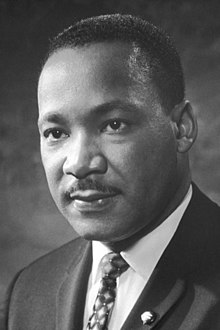
Martin Luther King%2C Jr..
(Image by Wikipedia (commons.wikimedia.org), Author: Nobel Foundation) Details Source DMCA
Duluth, Minnesota (OpEdNews) June 28, 2023: In Jonathan Eig's new 2023 biography King: A Life (Farrar, Straus and Giroux), he highlights the Reverend Dr. Martin Luther King's repeated womanizing (pp. 5, 72-73,104, 190, 242, 270-273, 325-326, 352-355, 389-391, 396-398, 400, 405, 425, 451, 512, 516, 535, and 555) - and his repeated practice of plagiarism (pp. 51, 68, 76, 111-112, and 202).
Fortunately, Eig also emphasizes King philosophy of nonviolence (pp. 4, 31, 33, 60, 78, 84, 162, 165-168, 170, 178, 188, 207, 209, 211-213, 216, 221, 226, 229, 253, 264, 265, 267-269, 280, 287, 296, 299, 303, 374, 384, 401, 432, 455, 459-460, 462, 467- 468, 476-477, 485, 487, 488, 494-495, 499, 509, 514, 520, 528, 532, 534, 541, and 544-545).
Because the black Baptist minister King was noteworthy for articulating his philosophy and practice of nonviolence, the American philosophy professor John J. Ansbro set out to study King's academic education in his 1982 book Martin Luther King, Jr.: The Making of a Mind (Orbis Books) - a work that Eig does not refer to. The dust jacket on Ansbro's 1982 book features glowing burbs about it by (in alphabetical order) John C. Bennett, Julian Bond, Ramsey Clark, William Sloane Coffin, Jr., Richard A. Long, Walter G. Muelder, and Bayard Rustin.
On the back inside flap of the dust jacket on Ansbro's 1982 book, we are told that Ansbro, with the financial assistance of a travel grant from the Ford Foundation, "interviewed Dr. King's professors at Morehouse College, Crozer theological Seminary, and Boston University, and his colleagues in the Southern Christian Leadership Conference" - in addition to studying "Dr. King's papers in the King Collection at the Mugar Memorial Library of Boston University, and source material at the Martin Luther King, Jr. Center for Nonviolent Social Change."
In the detailed table of "Contents" in Ansbro's 1982 book (pp. xi-xii), we learn that Chapter 1: "The Redemptive Power of Agape [Love]" (pp. 1-36) includes subsections "Davis's Conception of the Necessity of Agape [Love]" (pp. 15-17) and "DeWolf's Comprehensive Conception of Agape [Love]" (pp. 18-26).
Similarly, Chapter 2: "The Dimensions of Divine Providence" (pp. 37-70) includes the subsections "DeWolf's Conception of the God Who Sustains His Creatures" (pp. 38-60) and "Davis's Conception of the God in Control of History" (pp. 63-70).
Eig notes that George W. Davis "taught King for 30 of his 110 course hours" at the Crozer Theological Seminary in Pennsylvania (p. 82). Eig notes that L. Harold DeWolf was subsequently King's "dissertation adviser" at Boston University (p. 111) - in which King plagiarized part of the text.
Now, in Ansbro's subsection "Davis's Conception of the God in Control of History," he says, "He [Davis] affirmed the validity of the Hebraic-Christian linear conception of history as progress toward a predetermined goal, and [Davis also] rejected the ancient Greek conception of history as a process destined to bend back upon itself in endless cyclic repetition" (p. 63).
Concerning the ancient Greek cyclic conception, see Lynne Ballew's book Straight and Circular: A Study in Greek Philosophy (Van Gorcum, 1979).
The classic study of ancient cyclic thought is Mircea Eliade's book The Myth of the Eternal Return, translated from the French by Willard Trask (Pantheon Books, 1954; orig. ed., 1949).
But also see the American Jesuit Walter J. Ong's essay "Evolution and Cyclicism in Our Time" in the now-defunct Jesuit-sponsored journal Thought: A Review of Culture and Idea (Fordham University), volume 34, serial number 135 (Winter 1959-1960); pp. 547-568; Ong reprinted it in his 1967 book In the Human Grain: Further Explorations of Contemporary Culture (Macmillan, pp. 61-82); it is also reprinted in volume two of Ong's Faith and Contexts, edited by Thomas J. Farrell and Paul A. Soukup (Scholars Press, 1992b, pp. 85-103).
In any event, according to Ansbro, "The first major shift Davis discovered in the historical process was the transition from external controls to inner sanctions" (p. 63; italics in Ansbro's text).
"The second major shift that for Davis was evidence of God's control of history was the transition from the impersonal to the personal" (p. 64; italics in Ansbro's text).
"While acknowledging the existence of absolutism and autocracy and their effect on millions of persons, Davis maintained that the thirds major shift in history was the transition from rank individualism to the solidarity of the social group, which enhances the realization of the personal" (p. 66; italics in Ansbro's text).
(Note: You can view every article as one long page if you sign up as an Advocate Member, or higher).




